Iceland has produced some talented football players over the years, most notably Eiður Guðjohnsen and Gylfi Sigurðsson
. The former won two Premier League titles with Chelsea under Portuguese boss Jose Mourinho, whilethe latter is arguably the nation’s best player, playing under Carlo Ancelotti.
The national side has reached relative success recently, qualifying for their first-ever World Cup finals back in 2018, but mainly due to their small population, top talent is few and far between.
However, there is one Icelandic player who is tipped for great things if he can manage to develop as expected – Ísak Bergmann Jóhannesson, son of former Leicester City player Jóhannes Guðjónsson.
Jóhannesson currently plays for IFK Norrkoping in the Allsvenskan and has turned quite a few heads with his performances for the Swedish club.
The Icelander is merely 17 years old but has already made his international debut, coming off the bench in a UEFA Nations League game against England back in November 2020.
According to reports, Jóhannesson has
recently been scouted by numerous top clubs, including Juventus, Liverpool, and Manchester United. Each club iskeeping a watchful eye on the youngster’s development over the coming months.
In this tactical analysis article, which will be
a scout report, we will examine Johannesson’s overall style of play andweaknesses.
It will also be an analysis of how the teenage sensation fits into IFK Norrköping’s tactics.
Ísak Bergmann Jóhannesson Player Profile
One of the youngster’s most interesting aspects, mainly from a tactical perspective, is his versatility in terms of playing in a number of roles already in professional football.
In the Allsvenskan 2020, former Norrkoping manager Jens Gustafsson used Jóhannesson in numerous positions in the midfield and the front line.
He even filled in at left-back in one of their final games of last season.
Gustafsson has since been replaced after four years in charge with Rikard Norling, so it will be interesting to see if the new manager uses Johannesson’s versatility to the same extent as his predecessor.
Last season, 18 percent of the left-footer’s games were up front, usually as part of a two-man strike partnership, whilst 26 percent were on the flanks, 13 percent being on the left, and 13 percent on the right.
The 17-year-old also played 24 percent of his games in the centre of the park, generally as a left central midfielder in a 4-1-4-1.
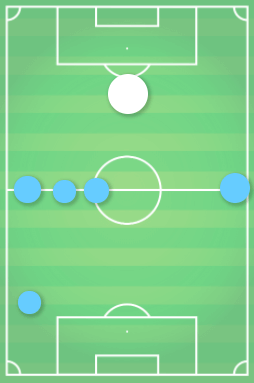
This visual representation shows the wide array of positions that Jóhannesson has played for Norrkoping in the past calendar year.
The bigger the circle, the more he played in that position.
Generally, in the bigger games, Jóhannesson is deployed out wide, whereas, in matches against lesser opposition to Norrkoping, who finished 6th in the Allsvenskan 2020, the youngster is played in a central position or even upfront.
His heat map also shows how versatile the teenager is. One can see that Jóhannesson is involved in quite a lot of action, particularly on the left flank and left halfspace, which are the areas of the pitch that he predominantly operates in when playing.
Ísak Bergmann Jóhannesson Heat Map
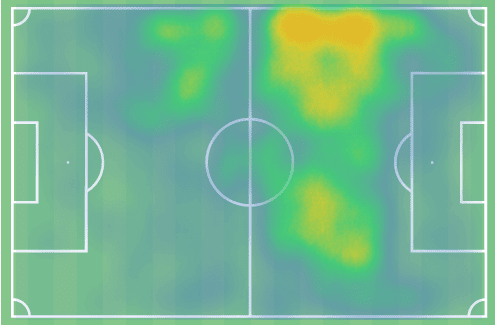
At 5’11” and 67kg, Jóhannesson is a well-built player.
Because of his age, his body could grow slightly more than it already has.
He possesses a wide array of skills, but perhaps his best is his tidiness in possession and ability to play under pressure, which aids Norrkoping in their play.
We will delve deeper into these qualities later in the scout report.
In comparison with the rest of the league’s players who are under the age of 20, Jóhannesson ranks considerably higher on numerous metrics, including assists per 90 (A/90), key passes per 90 (KP/90), percentage of successful dribbles (DR%), passing accuracy (P%) and also passes to the final third (P3/90), which can be seen from the following data representation:
Ísak Bergmann Jóhannesson Radar Map
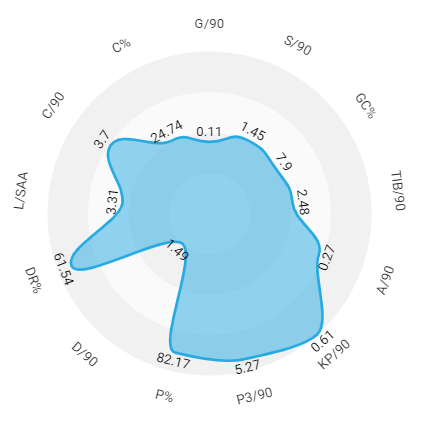
Ísak Bergmann Jóhannesson Style Of Play
When Norrkoping have possession of the ball, they play a very expansive style of football, one which is very interesting to watch from an analytical standpoint.
Last season, their shape constantly changed when they were in the attacking phases of play.
Typically, they used a 3-1-5-1/3-1-4-2 when they were in a positional attack.
In this highly expansive possession structure, they overloaded players between the lines in a system similar to that of RB Leipzig under Julian Nagelsmann.
This structure suits Jóhannesson down to a tee, as he excels when receiving balls between the lines.
It allows him to take it on the half-turn and play forward or else play out to the advanced fullback on the flanks.
He allows himself to receive so many passes by creating excellent and intelligent passing angles for his teammates to play line-breaking passes through the opposition.
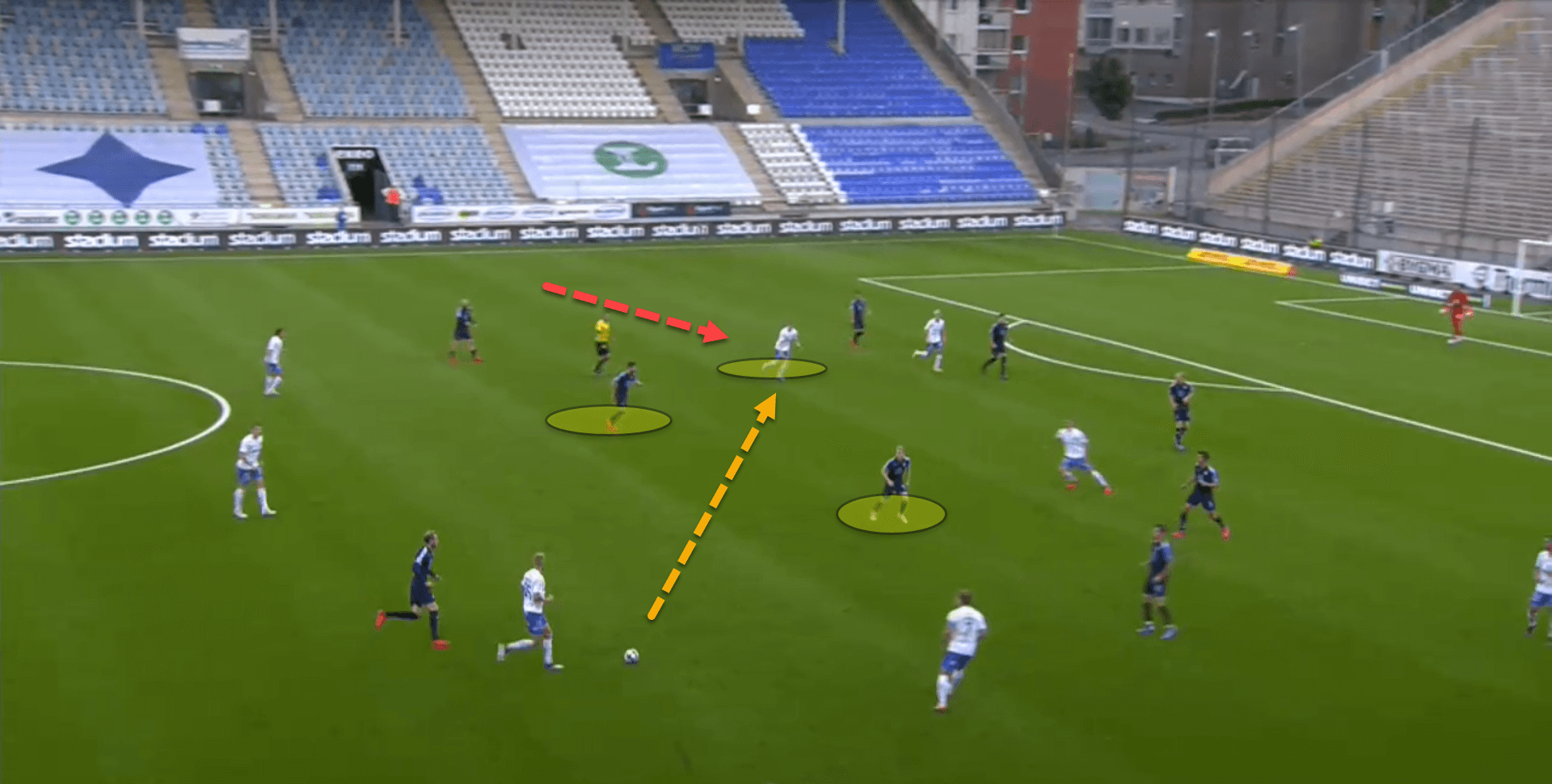
By creating good passing angles between the lines, he is allowing Norrkoping to play forward centrally through their opponent’s defensive structure as quickly as possible.
In the scenario shown in the previous image, Jóhannesson has spotted a gap between the opposition’s two central midfield players due to their inability to cut off passing lanes between the lines.
He pushes into the space between them and gives his team an advantageous progressive passing option to play forward quickly through their opponent’s block.
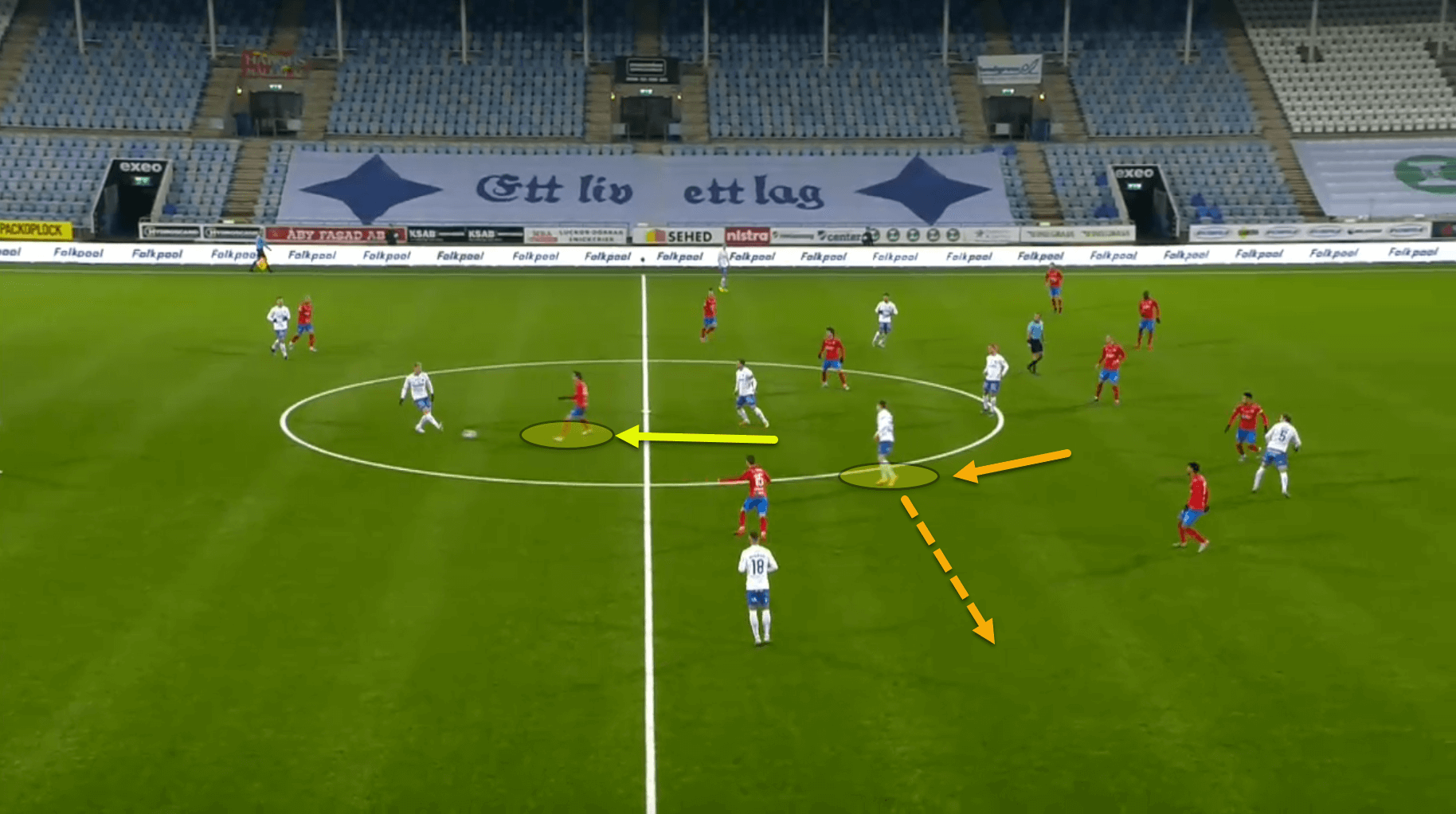
Again, here, the central midfielder has stepped out to close down the ball carrier, and so Jóhannesson drops slightly to receive in the space left by the pressing midfielder.
This allows him to link up with the fullback on the flank and progress forward.
From these positions, the 17-year-old can be very dangerous at threading through balls behind a defensive line.
He has an excellent vision for such a young player and is very capable of creating high-quality chances for his team.
Last season, he had an average of 0.61 key passes per 90 in the Allsvenskan and an expected assists rate per 90 (xA/90) of 0.2, which was one of the highest in the division in 2020.
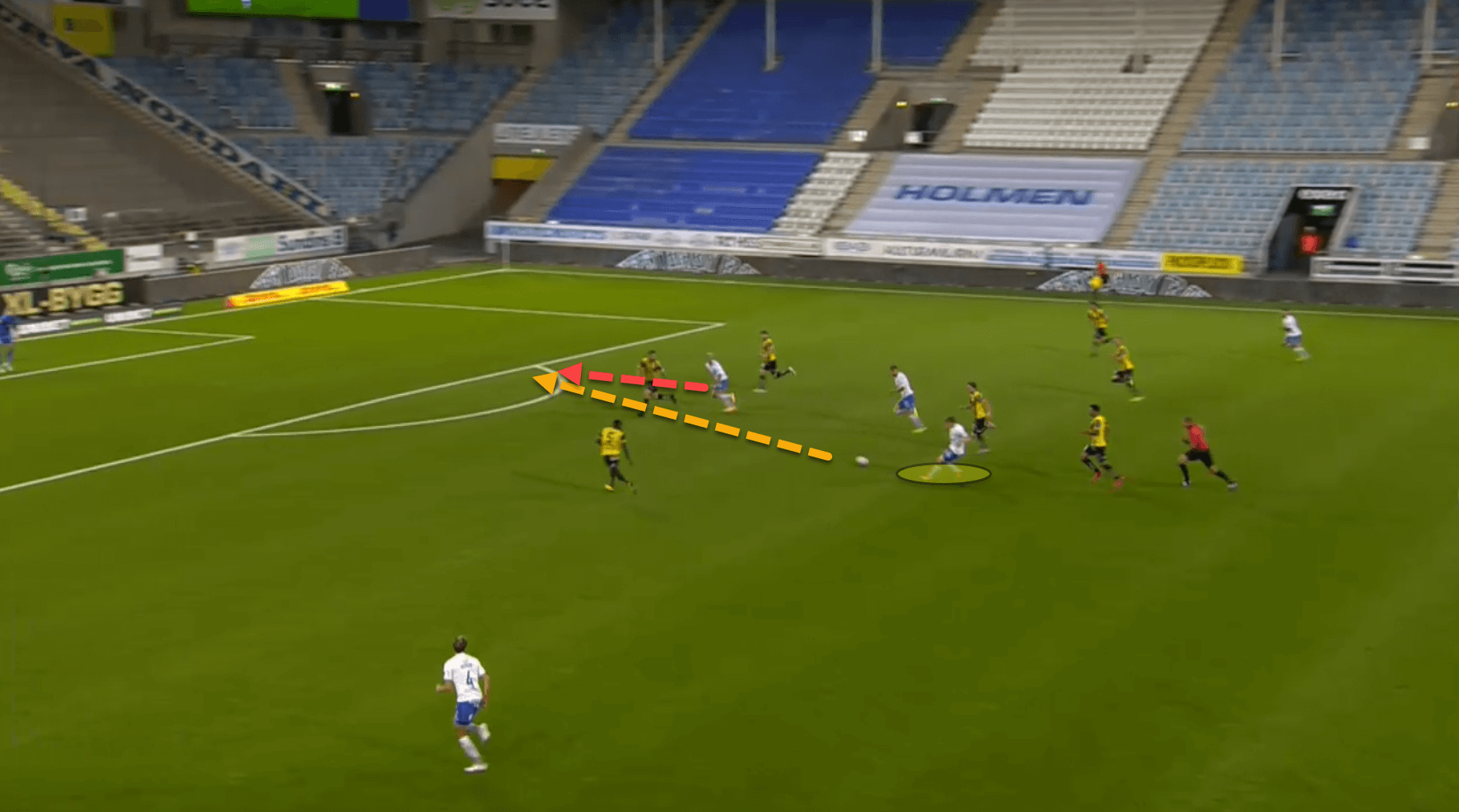
Ísak Bergmann Jóhannesson Spatial Awareness And Tactical Intelligence
One of the most important aspects of a young footballer’s development in the modern game is their ability to grow their tactical understanding alongside their technique.
For such a young player on the scene, Jóhannesson is already showing an obvious understanding of the tactical side of football, such as his comprehension of space and finding where space is likely to be before it has even opened up.
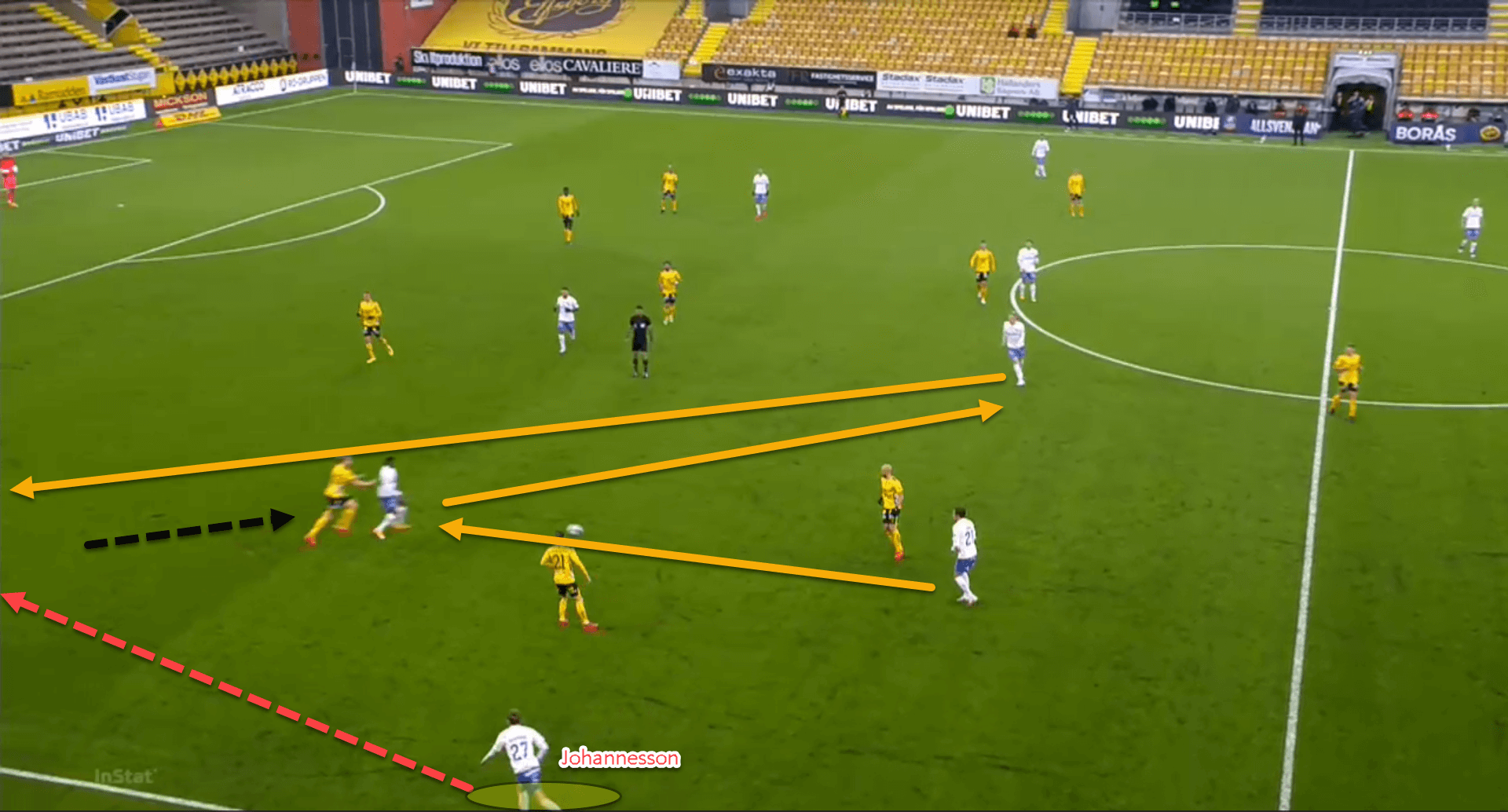
In this image, Jóhannesson has made a run into space on the flank before it has even developed.
He scanned the situation around him and saw that, as the play unfolded, the opposition’s fullback would be attracted to the winger, leaving space on the flank for him to make a run into.
The Icelander clearly understands the tactical instructions bestowed upon him by his manager.
His versatility at Norrkoping has shown this to be true. As already stated in an earlier section, he has been trusted to play a number of positions all over the park.
Although his favoured position seems to be through the centre as a central midfielder, Jóhannesson is able to adapt his game to the manager’s instructions.
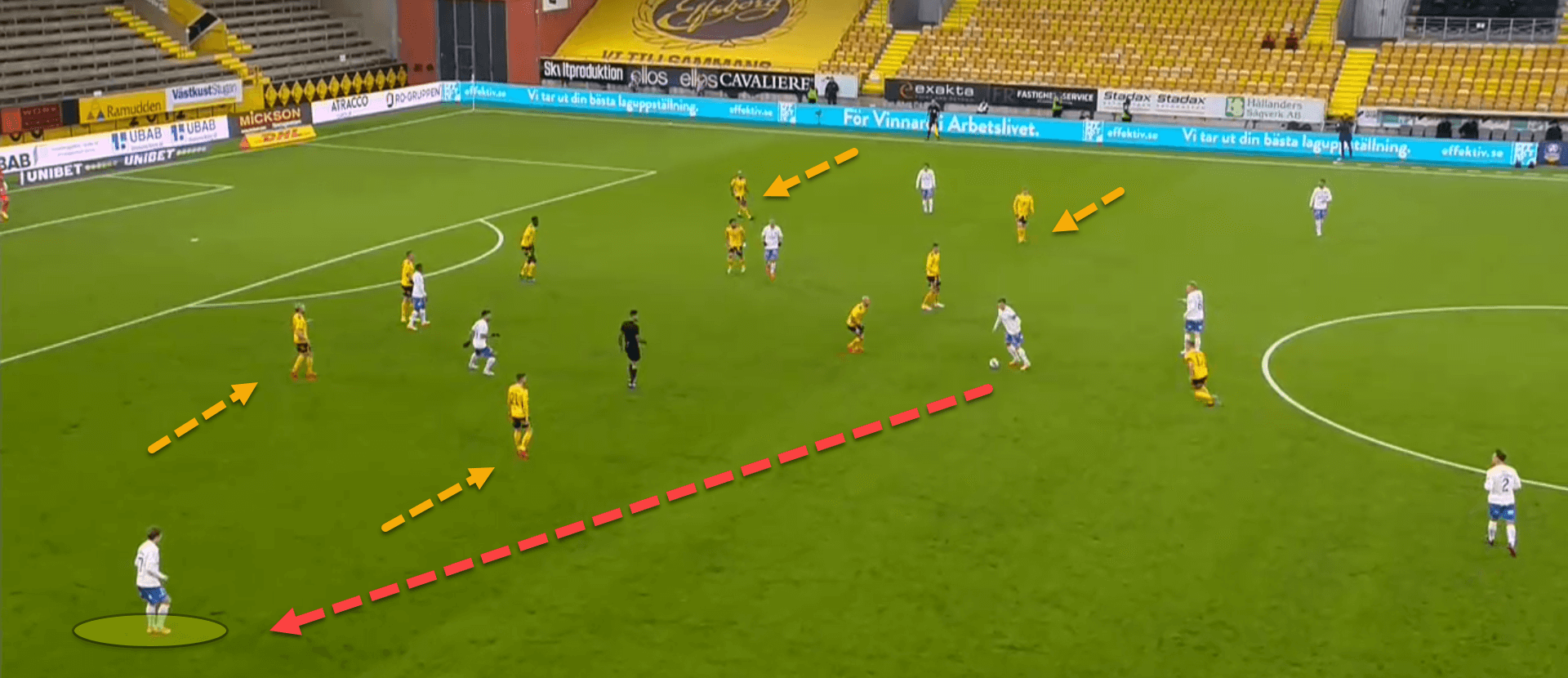
In this image, the youngster was instructed to hold the width on the left side of the pitch as the opposition was defending in a very narrow and compact low block.
By Jóhannesson holding the width, Jóhannesson stretched that defensive block and offered an option to cross out wide if no players were available centrally.
Generally, when he plays out wide or in the centre of the park, Jóhannesson drifts close to the ball to get involved in the play.
However, in this situation, he was very tactically disciplined in his positioning and executed his manager’s instructions.
Ísak Bergmann Jóhannesson Positioning
When Jóhannesson has the ball in the wide areas of the pitch, he likes to attack in two ways.
First, he makes lots of penetrative runs in the halfspace, underlapping the fullback on his side.
Second, he drops off and looks to play an out-swinging ball into the box, giving himself plenty of room to pick the right pass.
Whether playing as an advanced midfielder in a 4-1-4-1/4-3-3 or as a winger, Jóhannesson likes to play in the halfspace in close proximity with the fullback and the other central midfielders.
As we already touched on, when he receives the ball, he looks to link up with the fullback.
When he plays the ball into the fullback, Jóhannesson tends to make a penetrative run behind the opposition’s backline to find room to cross the ball on the fullback/wingback’s blindside.
He currently averages 3.7 crosses per 90, with a success rate of 24.74 percent.
Thus, essentially, just one in four of his crosses reaches a teammate, which can be drastically improved.
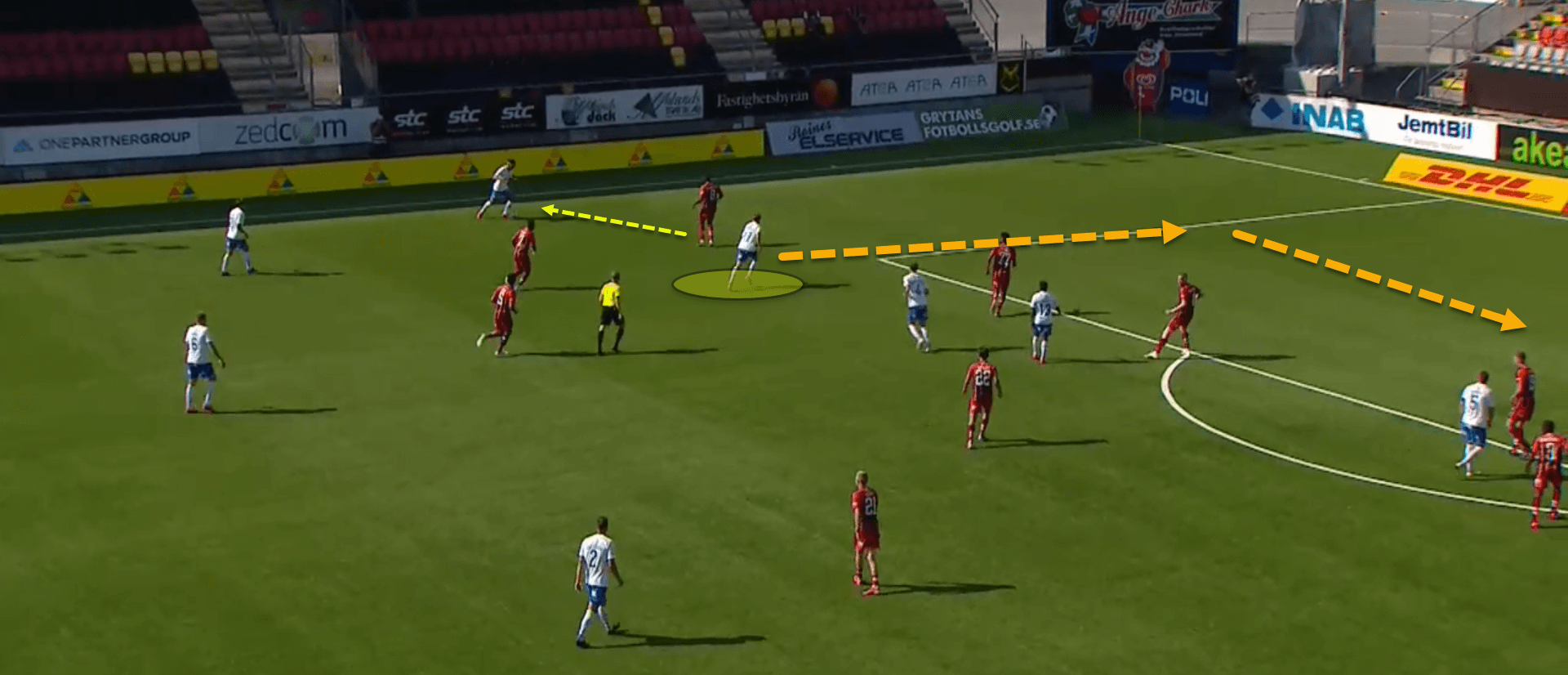
This image shows Jóhannesson making an excellent blindside run in the halfspace between the opposition’s fullback and ball-near centre-back.
From here, the ball carrier can slip him in at the assist zone, where he is in an optimal position to cross the ball, usually on the floor.
These halfspace runs from central midfielders are the kind of runs that Manchester City are so skilled at before cutting the ball back in the box and allowing a player to take a high-quality shot on goal.
However, he does not always make these runs.
A lot of the time, Jóhannesson drops off when the opposition’s block has collapsed back into their own penalty area in order to deliver a deep, out-swinging ball from the edge of the box.
He takes a lot of Norrkoping’s set-pieces, including corners and free-kicks, and so positioning himself in deeper positions allows him to receive the ball and have time to kill the ball and deliver in a set-piece-type fashion.
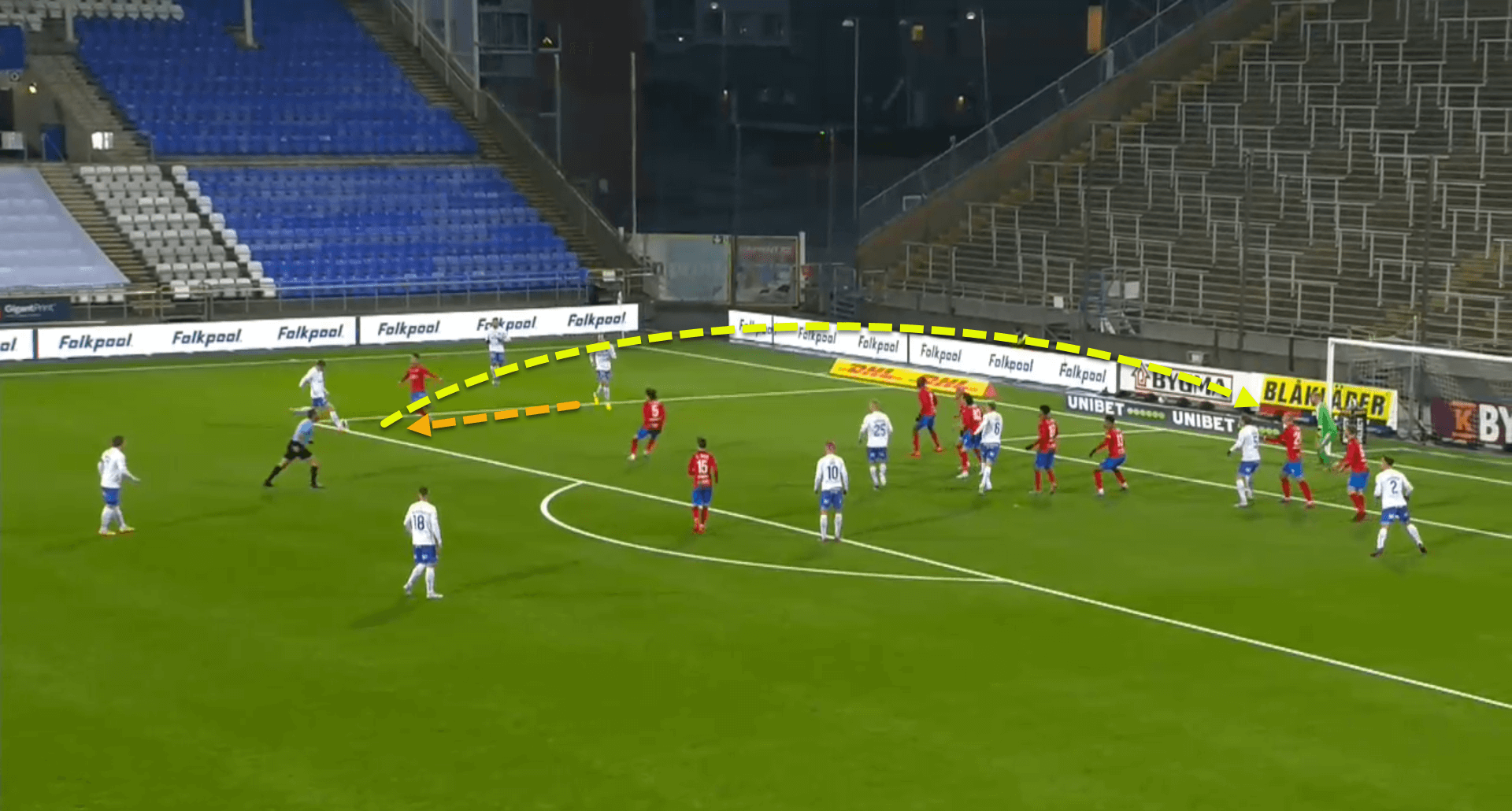
Here, the opposition are parked in their own box from the second phase of a corner kick.
Jóhannesson positioned himself at the edge of the 18-yard box and received the ball from a back pass.
He usually does this on the left flank, as he is left-footed and can deliver an out-swinging ball.
This really suits his style of play, and he is very adept at crossing from these types of situations due to his set-piece speciality.
Delivering a good out-swinging cross also makes it very difficult for the goalkeeper to judge whether to leave his line or stay put.
Ísak Bergmann Jóhannesson Defensive Abilities
Johannesson’s defensive game is quite good, hence why he has been trusted to fill in at left back in some games.
Once again, this relates to his game intelligence from a tactical standpoint.
On average, he competes in 4.62 defensive duels per 90 minutes, winning 42.1 percent of them.
More impressively, he has also averaged 3.44 interceptions per 90 minutes since the beginning of last season.
Jóhannesson has quite a decent build in terms of his physique, as we already mentioned earlier in this scout report, which allows him to press his opponents aggressively, cutting off passing lanes behind him using his frame.
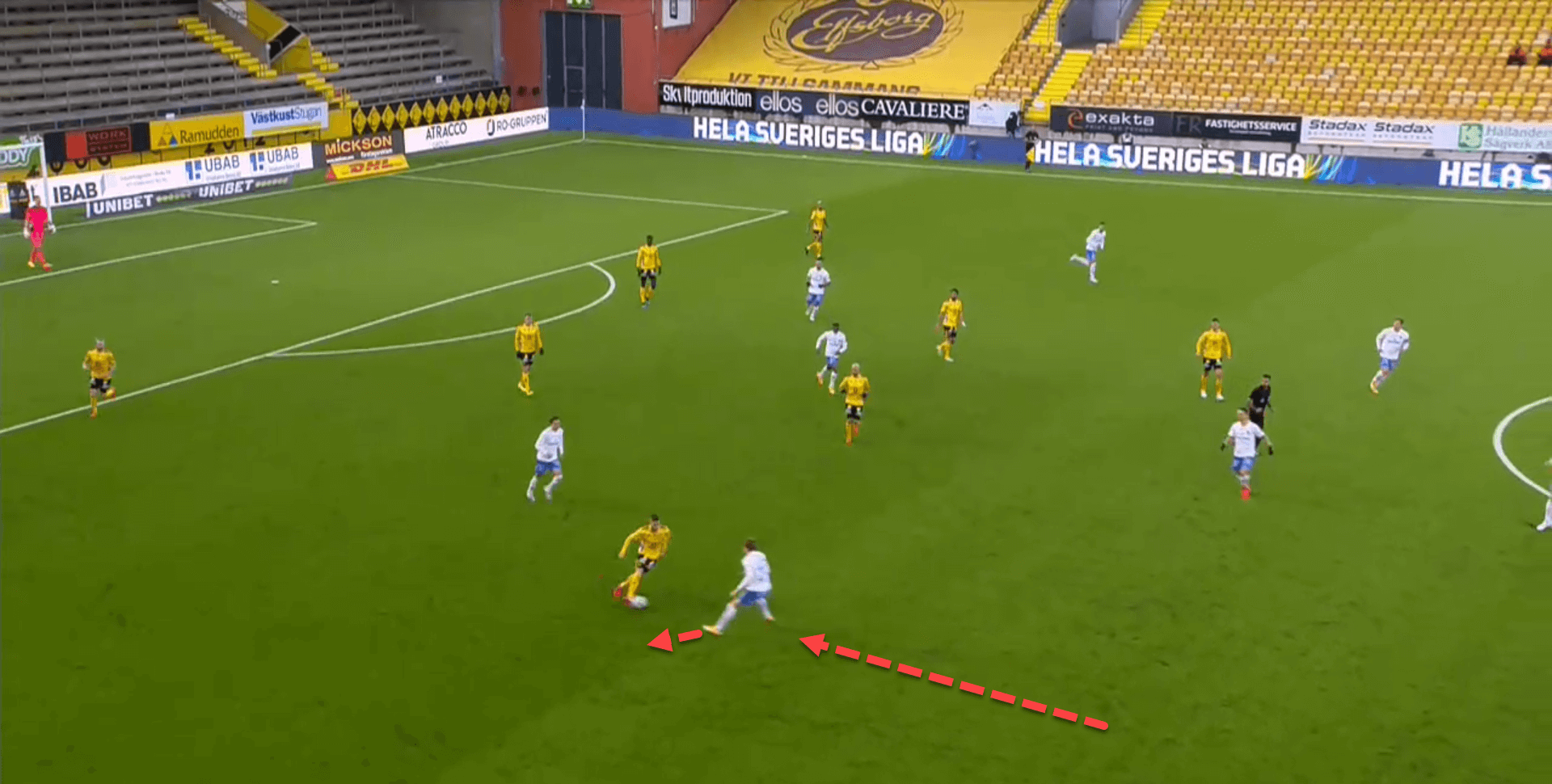
Here, we can see Jóhannesson using his frame to full capacity to intercept an opponent in a 1v1 duel.
He got very tight to the ball carrier, forcing him to try to take him on, but with his excellent stance, while pressing, he stopped the player in his tracks.
The Icelander averages 4.7 ball recoveries per game, with 51.2 percent coming in the opposition’s half of the field.
As the last image shows, he is also very good at counter-pressing and constantly tracks back to recover the balls that he has lost.
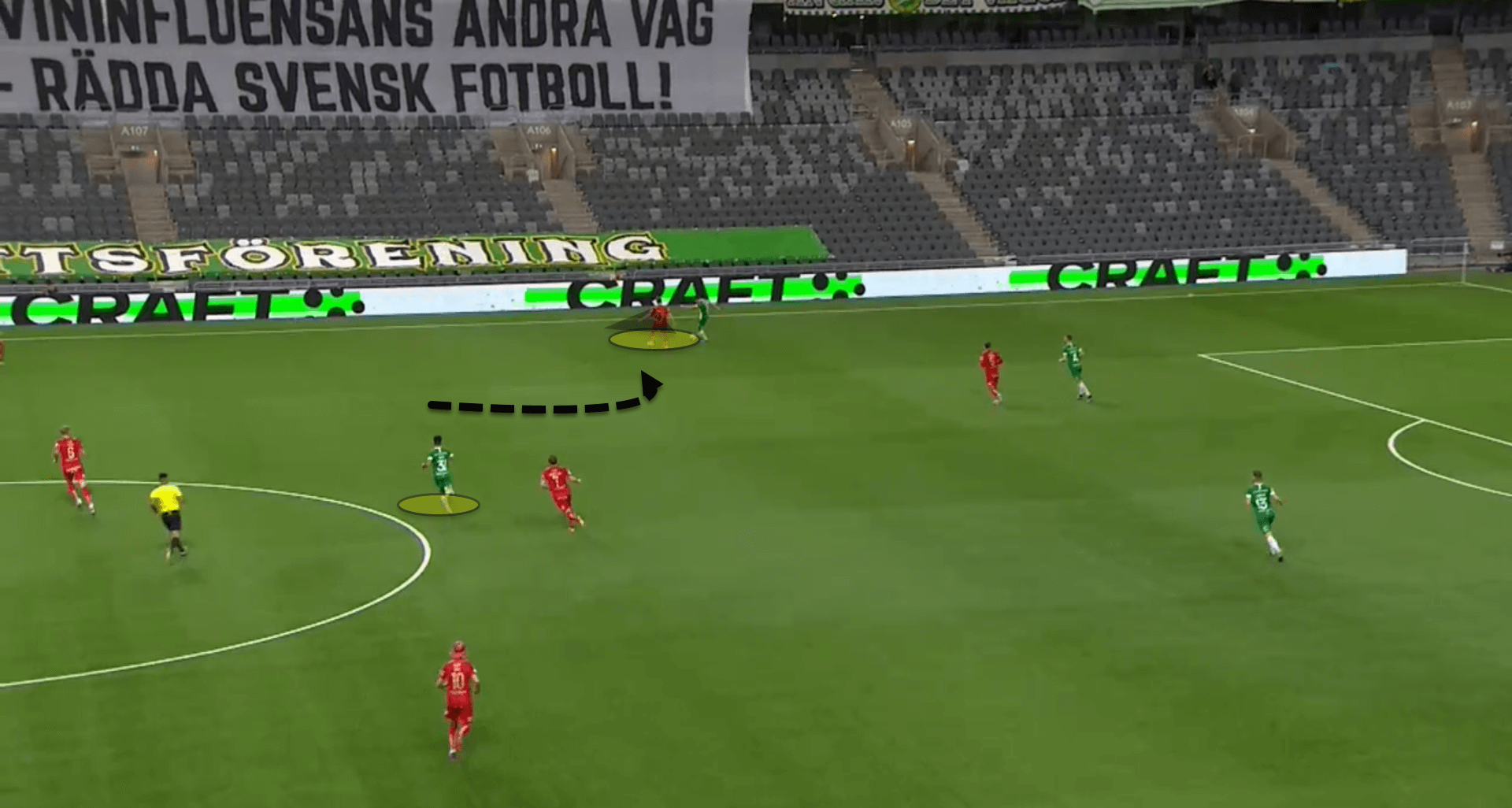
Again, here, Jóhannesson has angled his run from in to out to cut off the fullback’s inside passing lanes while also applying a cover shadow to the pivot in midfield.
This shows a more clear understanding of his defensive duties, which is an extremely important skill for a young player.
Ísak Bergmann Jóhannesson Areas To Improve
Jóhannesson is quite good in every aspect of his game and possesses no standout or significant weaknesses, but as with every young player, he could improve in certain areas.
One of these areas is his risk-taking.
While being very patient and tidy in possession is never necessarily a bad trait for any midfielder, Jóhannesson tends to play very safely even when he does not need to.
In the Allsvenskan last year, the youngster only averaged 8.31 forward passes per 90 despite being an advanced central midfielder and winger for the majority of those games.
In fact, he averaged more back passes per 90 than forward passes, with 9.23, showing that he tends to be very safe in possession and does not like to risk giving up possession.
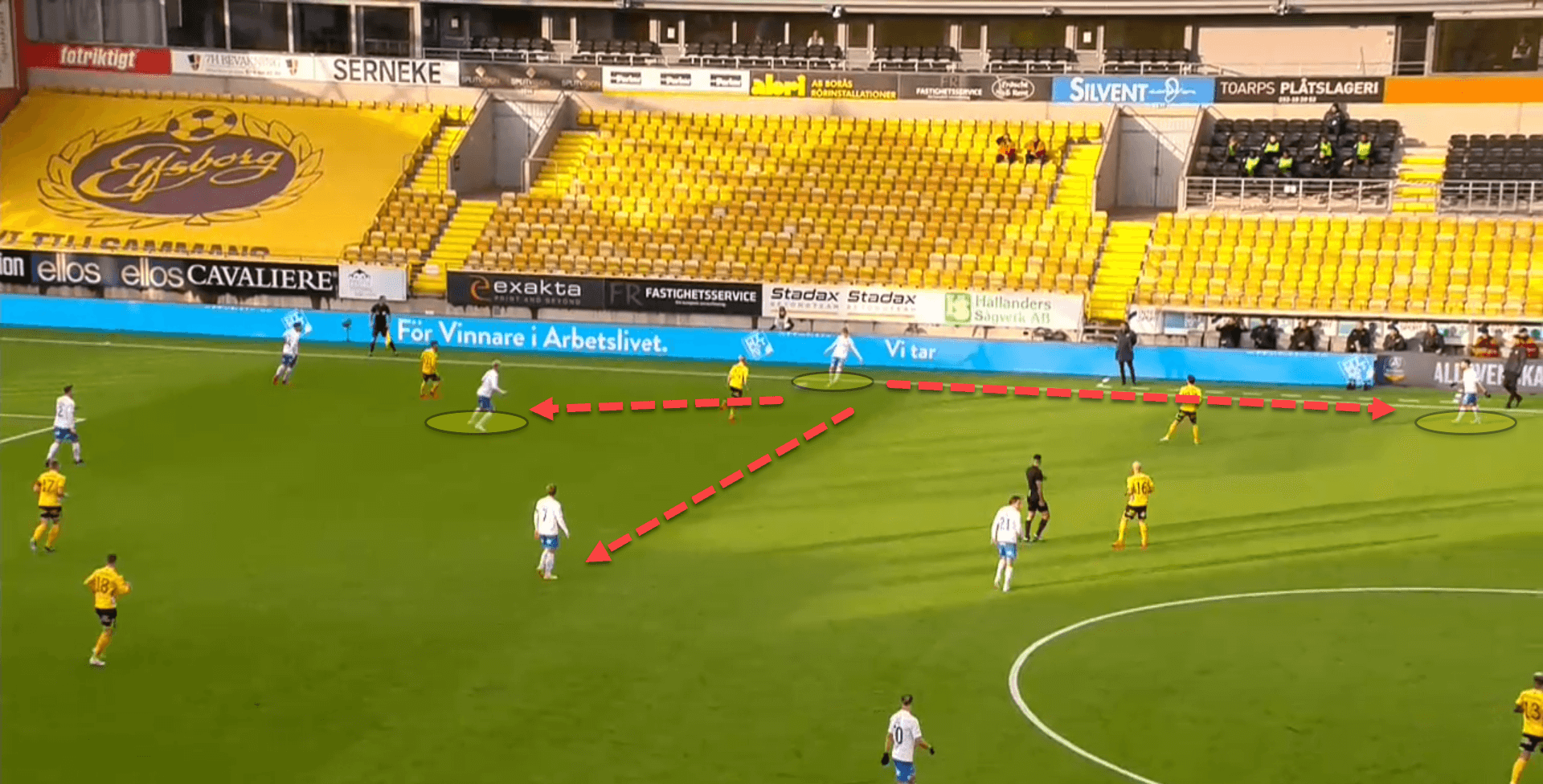
This image shows a scenario in which Jóhannesson has a great opportunity to progress his team and put them in a much better position on the pitch.
He has three free passing options, down the line, an inside pass to the centre of the pitch, or else a square pass to his diagonal right.
He chose the option to his diagonal right, but this was the safest of the three options.
In these situations, the youngster needs to take more risks and avoid always choosing the easy option.
Sometimes, the easy option is essential for ball retention.
Still, when there are free players in optimal passing positions, Jóhannesson needs to try and feel more comfortable with his own ability to find them in order to progress his side forward.
Conclusion
Jóhannesson looks to be a fantastic player at just 17 years of age, and from watching him, one can see why some of the biggest clubs in world football are currently after his signature.
His ability to hold possession, play in tight spaces, and maintain the ball under pressure makes him very easy on the eye.
With the right coaching and the right move, the Icelander could play for one of Europe’s best teams in just a few seasons, provided he chooses the right career path and continues his projected development.
However, right now, it is also important for him to remain level-headed in Sweden for the next couple of months during all this transfer talk.
He is certainly one to watch for the future.

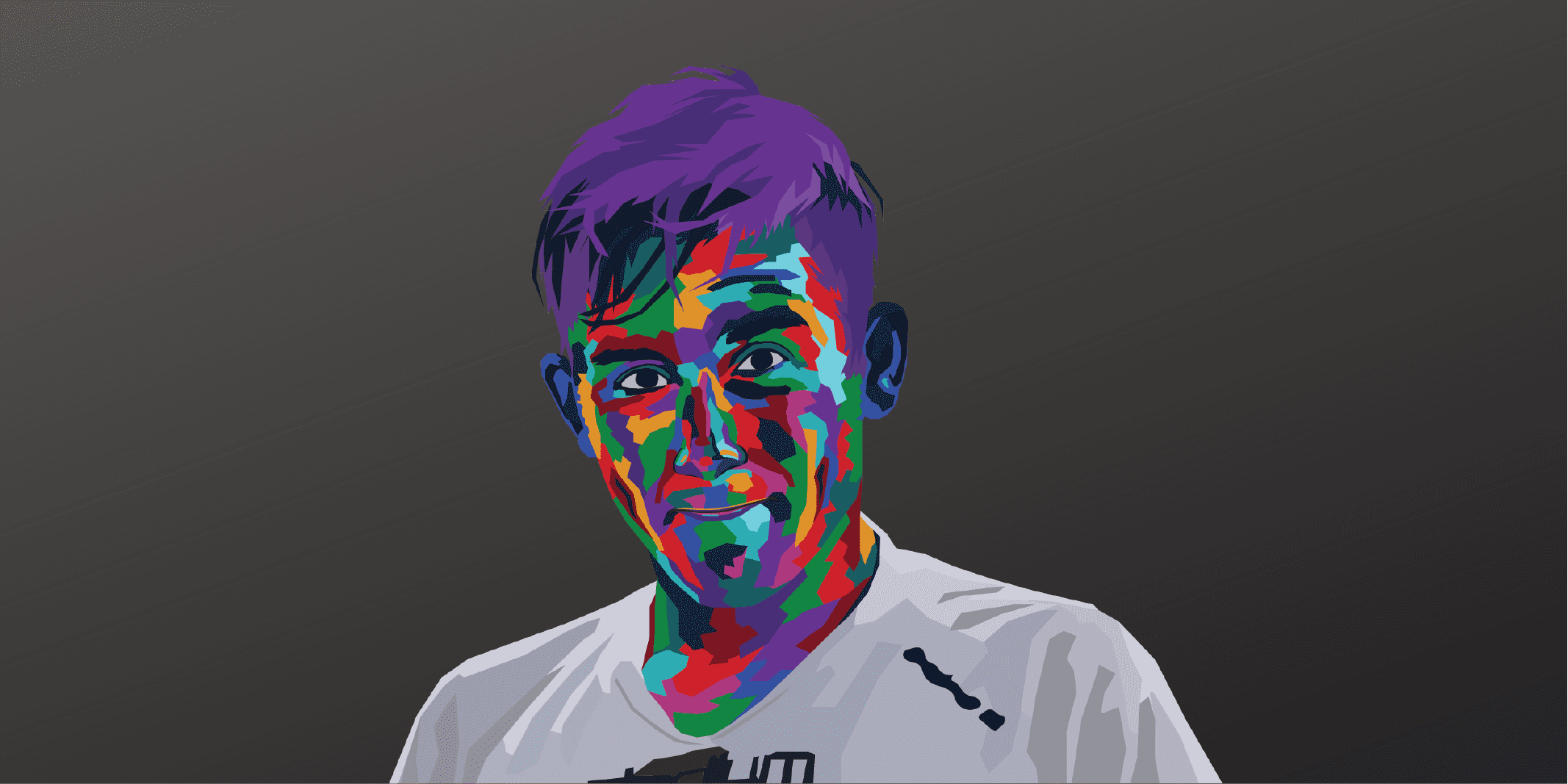




Comments